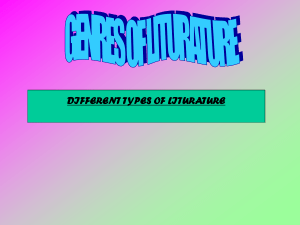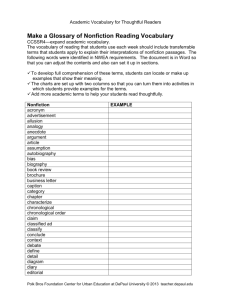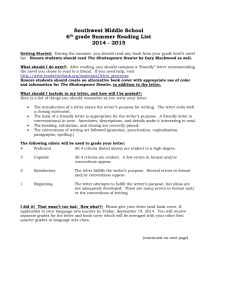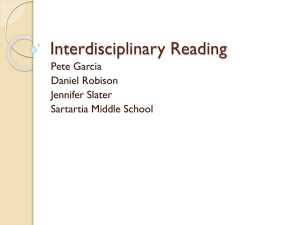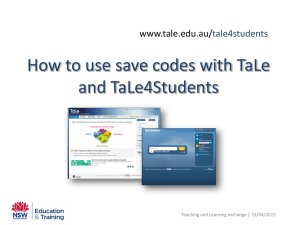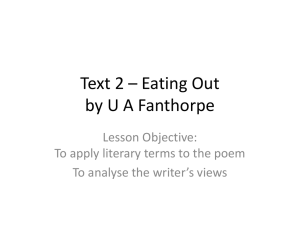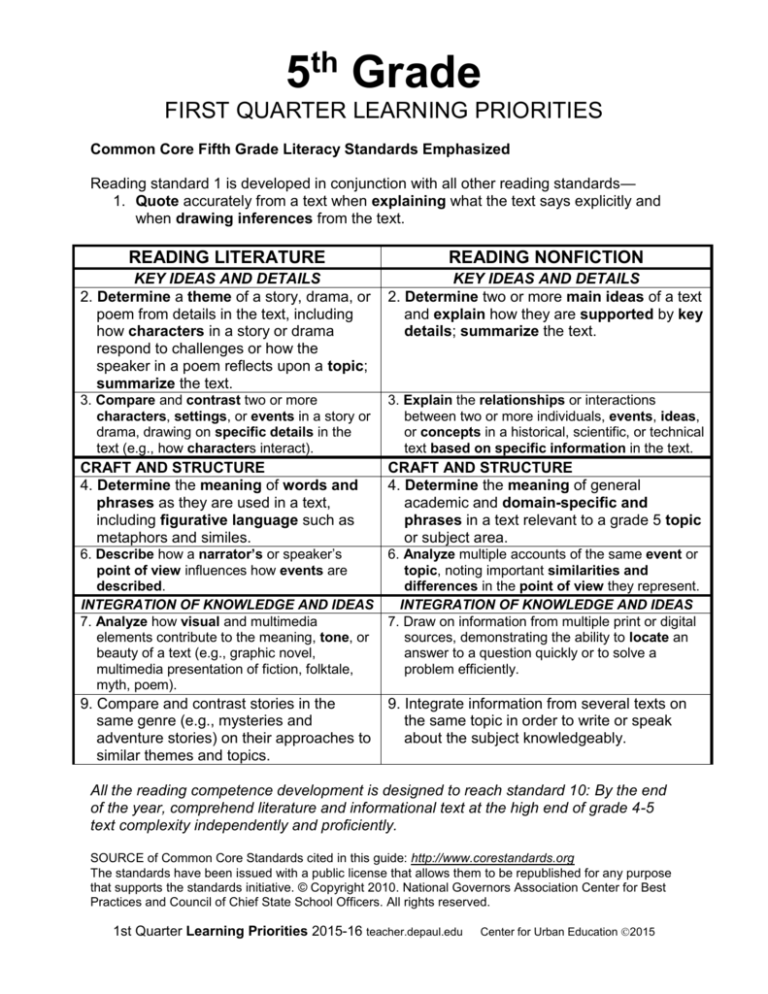
5th Grade
FIRST QUARTER LEARNING PRIORITIES
Common Core Fifth Grade Literacy Standards Emphasized
Reading standard 1 is developed in conjunction with all other reading standards—
1. Quote accurately from a text when explaining what the text says explicitly and
when drawing inferences from the text.
READING LITERATURE
READING NONFICTION
KEY IDEAS AND DETAILS
2. Determine a theme of a story, drama, or
poem from details in the text, including
how characters in a story or drama
respond to challenges or how the
speaker in a poem reflects upon a topic;
summarize the text.
KEY IDEAS AND DETAILS
2. Determine two or more main ideas of a text
and explain how they are supported by key
details; summarize the text.
3. Compare and contrast two or more
characters, settings, or events in a story or
drama, drawing on specific details in the
text (e.g., how characters interact).
3. Explain the relationships or interactions
between two or more individuals, events, ideas,
or concepts in a historical, scientific, or technical
text based on specific information in the text.
CRAFT AND STRUCTURE
4. Determine the meaning of words and
phrases as they are used in a text,
including figurative language such as
metaphors and similes.
CRAFT AND STRUCTURE
4. Determine the meaning of general
academic and domain-specific and
phrases in a text relevant to a grade 5 topic
or subject area.
6. Describe how a narrator’s or speaker’s
point of view influences how events are
described.
INTEGRATION OF KNOWLEDGE AND IDEAS
7. Analyze how visual and multimedia
elements contribute to the meaning, tone, or
beauty of a text (e.g., graphic novel,
multimedia presentation of fiction, folktale,
myth, poem).
6. Analyze multiple accounts of the same event or
topic, noting important similarities and
differences in the point of view they represent.
INTEGRATION OF KNOWLEDGE AND IDEAS
7. Draw on information from multiple print or digital
sources, demonstrating the ability to locate an
answer to a question quickly or to solve a
problem efficiently.
9. Compare and contrast stories in the
same genre (e.g., mysteries and
adventure stories) on their approaches to
similar themes and topics.
9. Integrate information from several texts on
the same topic in order to write or speak
about the subject knowledgeably.
All the reading competence development is designed to reach standard 10: By the end
of the year, comprehend literature and informational text at the high end of grade 4-5
text complexity independently and proficiently.
SOURCE of Common Core Standards cited in this guide: http://www.corestandards.org
The standards have been issued with a public license that allows them to be republished for any purpose
that supports the standards initiative. © Copyright 2010. National Governors Association Center for Best
Practices and Council of Chief State School Officers. All rights reserved.
1st Quarter Learning Priorities 2015-16 teacher.depaul.edu
Center for Urban Education 2015
Connect Reading and WRITING
Research to Build Knowledge—Nonfiction and Literature
7. Perform short, focused research tasks that build knowledge through investigation of
different aspects of a topic using several sources.
8. Gather relevant information from experience as well as print and digital sources; summarize
or paraphrase information in notes and finished work, and provide basic bibliographic
information.
9. Write in response to literary or informational sources, drawing evidence from the text to
support analysis and reflection as well as to describe what they have learned:
__a. Apply grade 5 reading standards to informational texts (e.g., “Explain how an author
uses evidence to support his or her claims in a text, identifying what evidence supports
which claim(s)”).
__b. Apply grade 5 reading standards to literature (e.g., “Compare and contrast two or more
characters, events, or settings in a text, drawing on specific details”).
Common Core Writing Narratives—CCSSW3—for fifth grade requires the following:
Write narratives in which they:
__a. Orient the reader by establishing a situation, introduce a narrator and/or
characters, and organize an event sequence that unfolds naturally.
__b. Use narrative techniques such as dialogue and description to develop events and
show the characters’ external behaviors and internal responses to events.
__c. Use a variety of temporal words and phrases to manage the sequence of events.
__d. Use concrete and sensory words and phrases to convey events and experiences
precisely.
__e. Provide a satisfying conclusion that follows from the narrative’s events.
Students can use that list to analyze a mentor text—analyze how the writer meets
those criteria.
Source: Sample Assessments at PARCCOnline.org
CONSTRUCTED RESPONSE ABOUT ONE READING
You have read a passage from “The Growin’ of Paul Bunyan.” Think about how the
story would be different if it were told from Johnny’s point of view. Write a narrative story
retelling the story from the point of view of Johnny. Be sure to use supporting details
from the passage.
CONSTRUCTED RESPONSE ABOUT TWO READINGS
The stories titled Ida B and Moon Over Manifest both include events that did not
happen. Write and essay describing how each narrator’s point of view influenced how
these events are described. Be sure to use details from both stories.
1st Quarter Learning Priorities 2015-16 teacher.depaul.edu Center for Urban Education 2015
2
The Speaking and Listening Standards are Keys to Learning
ACROSS the Curriculum
Comprehension and Collaboration
SL.5.1 Engage effectively in a range of collaborative discussions (one-on-one, in
groups, and teacher-led) with diverse partners on grade 5 topics and texts, building
on others’ ideas and expressing their own clearly.
__SL.5.1a Come to discussions prepared, having read or studied required material;
explicitly draw on that preparation and other information known about the topic to
explore ideas under discussion.
__SL.5.1b Follow agreed-upon rules for discussions and carry out assigned roles.
__SL.5.1c Pose and respond to specific questions by making comments that
contribute to the discussion and elaborate on the remarks of others.
__SL.5.1d Review the key ideas expressed and draw conclusions in light of
information and knowledge gained from the discussions.
SL.5.2 Summarize a written text read aloud or information presented in diverse
media and formats, including visually, quantitatively, and orally.
SL.5.3 Summarize the points a speaker makes and explain how each claim is
supported by reasons and evidence.
Presentation of Knowledge and Ideas
SL.5.4 Report on a topic or text or present an opinion, sequencing ideas logically
and using appropriate facts and relevant, descriptive details to support main ideas or
themes; speak clearly at an understandable pace.
SL.5.5 Include multimedia components (e.g., graphics, sound) and visual displays in
presentations when appropriate to enhance the development of main ideas or
themes.
SL.5.6 Adapt speech to a variety of contexts and tasks, using formal English when
appropriate to task and situation.
Students exercise Speaking and Listening competencies as they proceed through
the gradual release of responsibility.
Start a Glossary of Literature Interpretation Vocabulary
1st Quarter Learning Priorities 2015-16 teacher.depaul.edu Center for Urban Education 2015
3
CCSSR4—expand academic vocabulary.
The vocabulary of reading that students use each week should include transferrable
terms that students apply to explain their interpretations of passages and poems.
The two-week segments in this scope and sequence list literacy terms in the first
column, terms that teachers use to guide students to analyze texts and students should
use in discussions and writing responses to texts.
The following words were identified in NWEA requirements. Although NWEA has
identified some of these terms at lower “RIT” bands than grade 5, they are all relevant to
interpreting literature—once learned, they need to stay in use to continue to be applied
in students’ analysis of literature.
You can access this document on teacher.depaul.edu in Word set up as a chart into
which students can input examples—and so you can adjust it.
Mid-quarter, end-of-quarter, or weekly, students can organize the terms into
categories such as text structure, imagery….
To develop full comprehension of these terms, students can locate or make up
examples that show their meaning.
Add more academic terms to help your students read thoughtfully.
alliteration
analogy
anecdote
anthology
aphorism
archetype
assonance
author’s purpose
characteristics
characterization
cliché
climax
colloquialism
conclusion
conflict
connotation
consonance
context
detail
dialogue
diary
drama
emotion
evaluate
event
evidence
exaggeration
example
excerpt
exposition (fiction)
fable
fairy tale
falling action
fantasy
feeling
fiction
fictional
figurative language
figure of speech
first person
flashback
folk tale
foreshadowing
genre
historical fiction
humor
hyperbole
iambic pentameter
idiom
illustration
image
imagery
irony
legend
literary device
literary element
1st Quarter Learning Priorities 2015-16 teacher.depaul.edu Center for Urban Education 2015
4
literature
main character
metaphor
meter
minor detail
mood
moral
myth
narrate
narrative
narrator
novel
omniscient
onomatopoeia
order of events
oxymoron
parable
paradox
paragraph
parallelism
passage
phrase
play
plot
poem
poet
poetry
point of view
predict
pun
qualities
repetition
problem and
solution
resolution
resolve
respond, response
rhyme
rhythm
riddle
rising action
satire
scene
second person
selection
senses
sequence
setting
short story
simile
sonnet
stanza
structure
summarize,
summary
symbolism
support
suspense
symbol
symbolize
synecdoche
tale
tall tale
theme
third person
third person
omniscient
trait
title
title page
third person
objective
tone
viewpoint
voice
word play
world literature
1st Quarter Learning Priorities 2015-16 teacher.depaul.edu Center for Urban Education 2015
5
MATH MIX: New and Continuing PRIORITIES
Research confirms that if the math curriculum includes “frequent cumulative review” that enables students
to retain greater math competence. Among sources supporting this “mix” is the report “Assisting Students
Struggling with Mathematics” of the What Works Clearinghouse, IES Practice Guide, US Department of
Education. This chart is included to organize planning for new math content and inclusion of math
learned earlier in the school year in activities such as: learning centers; “bell ringers”; homework, art,
science, social science--Integrating math into science and social science makes math more meaningful.
Math Practice Standards should be emphasized
—particularly standard 1: Make sense of problems and persevere in solving them.
Week of
New Math
Math “Mix”—Content to Revisit
Homework Essential: Students need to take home an example of how to solve
problems—that teachers prepare or that they prepare so they can practice correctly.
Daily kinds of assessment:
__glossary __journal __my own example __change the problem, solve it
__ _______________ __ _________________________________
Weekly kinds of assessment:
__solve problem, explain patterns and strategies __write math booklet
__make my own “anchor chart” __make “math path”—steps to solution
__ __________________________ __ ________________
1st Quarter Learning Priorities 2015-16 teacher.depaul.edu Center for Urban Education 2015
6
Fifth Grade: First Quarter Learning Priorities Weeks 1-2
Literature and nonfiction literacy vocabulary listed for each two-week sequence should be incorporated in demonstrations and
guided reading and student responses. Writing is integrated into responses and tasks based on literature and nonfiction.
Literature Genre
Reading
Literature
Analyze character
development
(CCSSRL5.3)
Infer word meaning
from context. (5.4-Ongoing)
Week of September 7
Week of September 14
_ folk tale __tall tale _fable _ fantasy
_ folk tale __tall tale _fable _ fantasy _poem
_poem _myth __mystery _realistic fiction
_myth __mystery _realistic fiction __play
__play
Assess student abilities and interests, RELATE TRAITS /ACTIONS/MOTIVES
Infer character, motives, relate to plot and
Take reading interest survey.
author’s choices—how the writer creates a
RELATE CHARACTER TRAITS AND
character—dialogue, actions.
ACTIONS relates to organizing a
Make Chart, provide evidence for your
collaborative classroom
inference of motive
identify, classify and infer character
traits
LITERATURE
Make chart:
TERMS:
Character Trait_ Evidence_
CHARACTER
TRAITS; EVIDENCE;
DIALOGUE;
Draw characters, showing traits.
MOTIVE; SUMMARY
topic/trade book _ biography
Nonfiction
_ history __magazine __atlas
Sources
_video __textbook __encyclopedia
Science Inventory:
CCSSRI.5.2
What do you like about science?
Ideas of Science
What is a science topic you’ve
learned that you like a lot?
How did you learn about it?
What is an idea you learned?
Infer: what are the traits of a
scientist?
Recall and/or read about a person
Social Science
who helped others make progress.
CCSSRI.5.3
Analyze relationships What traits did that person
demonstrate?
What evidence in the passage
supports your inference?
Science
Writing
Organization—
CCSSW5.4
Assess interests and skills:
What do you like to write?
How do you write a good sentence?
Give an example.
How do you organize a good
Who
Does What
Why Evidence
Write a summary of your chart.
Start literary terms glossary (ongoing)
topic/trade book _ biography
_ history __magazine __atlas
_video __textbook __encyclopedia
How do scientists solve figure out
ideas? (May be based on a reading,
experiment, other source)
What is an important science discovery
and why is it important to know?
How do the parts of a science text help
you learn?
Read a passage about an important
person or event.
What challenges did people face?
What traits did they have that enabled
them to overcome them?
How do the parts of a social science
text help you learn?
What structure and techniques do you
find in this week’s story?
What did the writer do to keep you
interested?
paragraph?
Write a good paragraph about a
person you admire—it could be you.
Word Patterns
and Grammar
Assess grammar competence:
Knowledge of parts of speech
Knowledge of rules of grammar
Knowledge of punctuation.
Schedule Punctuation Focus
weeks based on assessment.
Identify parts of speech in a passage
List 5 nouns, 5 verbs, 5 adjectives, 2
adverbs. (Students can use them to
write sentences of their own.)
1st Quarter Learning Priorities 2015-16 teacher.depaul.edu Center for Urban Education 2015
7
Fifth Grade: First Quarter Learning Priorities Weeks 3-4
Literature and nonfiction literacy vocabulary listed for each two-week sequence should be incorporated in demonstrations and
guided reading and student responses. Writing is integrated into responses and tasks based on literature and nonfiction.
Literature Genre
Week of September 21
_ folk tale __tall tale _fable _ fantasy
_poem _myth __mystery
_realistic fiction __play
Analyze the plot:
What choices do characters
make, what problems do they
5.2—determine theme
5.5-analyze writer’s
face, how do they resolve them?
choices
How does the narrator help
LITERATURE
explain what happens?
TERMS: PROBLEM;
Why do you think the writer set
SOLUTION;
up this problem and solution—
MESSAGE;CHARAC
what message did the author
TER
want you to understand?
DEVELOPMENT;
Integrate writing/speaking/art:
NARRATOR
Add dialogue to a story. Present it
with expression.
Reading
Literature
Week of September 28
_ folk tale __tall tale _fable _ fantasy _poem
_myth __mystery _realistic fiction __play
Analyze the plot and character
development:
What choices do characters make,
what problems do they face, how do
they resolve them? How does the
narrator help explain what happens?
Why do you think the writer set up this
problem and solution—what is the
writer’s message?
How does the writer help you
understand the characters and
situation?
Integrate writing/speaking/art: Add
dialogue to a story. Present it with
expression.
Nonfiction
Sources
topic book _ biography
_ history __magazine __atlas
_video __textbook __encyclopedia
topic/trade book _ biography
_ history __magazine __atlas
_video __textbook __encyclopedia
Science
or
Social Science
Identify reasons to adjust rate of
Explain how to preview a nonfiction text.
Continue glossary (ongoing)
Describe how a text groups information
CCSSRI.5.2
Identify and support
ideas
LITERACY TERMS:
TEXT FEATURES;
COMPLEXITY OF
TEXT; CENTRAL IDEA ;
TEXT STRUCTURE
reading to complexity of text.
Identify important words (often
boldfaced) and start glossary.
Describe how a text groups
information into general categories
Use text structure to identify
main ideas.
Then determine central idea.
Identify how the writer uses text
features and illustrations to
communicate the ideas.
Integrate Writing
into general categories
Use text structure to identify main
ideas.
Then determine central idea.
Explain how the writer uses text
features and illustrations to
communicate the ideas.
Integrate Writing
Explain a challenge and response—
science or social science.
Explain a challenge and response— Then polish your writing (grammar,
science or social science.
Then polish your writing—
punctuation, subject-verb agreement)
punctuation, spelling.
Writing
expository
CCSSW2
Word Patterns
and Grammar
Analyze and use
singular/plural nouns
Write journal (ongoing) —can apply
to any subject—and SEL
Classify singular and plural
nouns and pronouns from a
passage
Singular
Write journal (ongoing) —can apply to any
subject—and SEL
Classify singular and plural verbs from a
passage
Singular
Plural
Plural
Make a list of rules (with examples)
for making plurals—e.g., when a
noun ends in -y you add -ies.
Correct subject-verb agreement errors in
an example. Then make your own
subject-verb agreement guide with your
own examples.
1st Quarter Learning Priorities 2015-16 teacher.depaul.edu Center for Urban Education 2015
8
Fifth Grade: First Quarter Learning Priorities Weeks 5-6
Literature Genre
Reading
Literature
CCSSRL.5.3
Compare characters
LITERATURE
TERMS:
EMOTIONS;
RESPONSE;
REACT;
CHALLENGE;
NARRATIVE;
SEQUEL;
PERSPECTIVE
Week of October 5
_ folk tale __tall tale _fable _ fantasy
_poem _myth __mystery
_realistic fiction __play
Week of October 12
_ folk tale __tall tale _fable _ fantasy
_poem _myth __mystery _realistic
fiction __play
Compare and contrast two
Compare and contrast two
characters within a story.
characters within a story.
How does the writer help the
Analyze the techniques the
reader identify the characters’
writer uses to communicate the
traits and feelings/emotions?
characters’ identities.
How do the characters react to the
Integrate writing/speaking/art:
same event?
Write about the story from the
How do they feel about the
perspective of one of the
challenge they face?
characters and from the
How do they react when the
perspective of the narrator.
problem is solved?
Compare and contrast their
perspectives.
Integrate writing/speaking/art:
Add dialogue to a story. Present it
Read statements by each one
with expression. Outline narrative
with expression consistent with
based on a story—outline what could
their attitudes.
happen in the sequel--the next part.
Draw the two characters you
contrasted. Show their traits.
Nonfiction
Sources
Topic book _ biography
_ history __magazine __atlas
_video __textbook __encyclopedia
Science
or
Social Science
Teacher asks FOCUS QUESTION TEACHER ASKS FOCUS
QUESTION
Use text features to Locate
Use text features to Locate
relevant information
relevant information
Classify information
Classify information
Use pictures, illustrations, details
in a text to identify central idea
Use pictures, illustrations,
CCSSRI.5.2
Analyze information
to identify ideas
LITERACY TERMS:
CENTRAL IDEA; TEXT
FEATURES;
SUPPORTING IDEAS;
ROOT WORD
and supporting ideas
INTEGRATE WRITING:
Write a summary of a section of the
text.
START LATIN AND GREEK
ROOT-WORD COLLECTION—
ONGOING.
Writing
Expository
CCSSW5.2
Word Patterns
and Grammar
Topic book _ biography
_ history __magazine __atlas
_video __textbook __encyclopedia
details in a text to identify
central idea and supporting
ideas
INTEGRATE WRITING:
Write a summary of a section of
the text.
CONTINUE LATIN AND
GREEK ROOT-WORD
COLLECTION—ONGOING.
Write journal (ongoing) —can apply to Write journal (ongoing) —can apply
any subject—and SEL
Make subject-verb agreement
guide with examples.
to any subject—and SEL
Make verb tense guide—with
examples.
1st Quarter Learning Priorities 2015-16 teacher.depaul.edu Center for Urban Education 2015
9
Fifth Grade: First Quarter Learning Priorities Weeks 7-8
Literature and nonfiction literacy vocabulary listed for each two-week sequence should be incorporated in demonstrations and
guided reading and student responses. Writing is integrated into responses and tasks based on literature and nonfiction.
Literature Genre
Reading
Literature
CCSSR5—analyze
how the parts fit
together—structure of
the story
CCSSR2—determine
the theme
LITERATURE
TERMS:
Theme; scene;
dialogue;
techniques; plot
Nonfiction
Sources
Science
or
Social Science
CCSSRI.5.2
Support an idea with
evidence.
CCSSRI5.9 Integrate
information from
different sources
LITERACY TERMS:
FOCUS QUESTION;
RELEVANT
INFORMATION; OUTLINE;
CITE; SOURCE
Writing
Explanatory
Word Patterns
and Grammar
Week of October 19
_ folk tale __tall tale _fable _ fantasy
_poem _myth __mystery _realistic
fiction __play
Week of October 26
_ folk tale __tall tale _fable _ fantasy
_poem _myth __mystery _realistic fiction
__play
Analyze how the author
Analyze how the author
communicates the theme
through the parts of the story—
how the scenes/events in the
story contribute to developing
that theme.
Integrate writing/speaking/art:
Plan a narrative on the same
theme as the story.
Identify the characters, plot, role
of the narrator.
Include list of characters with
drawings showing their traits.
topic/trade book _ biography
_ history __magazine __atlas
_video __textbook
__encyclopedia
Teacher Asks FOCUS
QUESTION
Students collect relevant
information from different
sources –may include video,
experiment, museum, …
INTEGRATE WRITING:
Outline then write your answer
to FOCUS question with cited
information from different
sources
Write the rules for organizing an
expository/explanatory text based
on a mentor text.
Make root word guide—how
communicates the theme through
the parts of the story—how the
scenes/events in the story
contribute to developing theme.
What techniques does the writer
use to help readers understand
the importance of events, how
characters change—the narrator,
dialogue, other techniques.
Integrate writing/speaking/art: write
the narrative outlined in previous
week
topic/trade book _ biography
_ history __magazine __atlas
_video __textbook __encyclopedia
Teacher Asks FOCUS QUESTION
Students collect relevant
information from different sources
–may include video, experiment,
museum, …
INTEGRATE WRITING:
Outline then write your answer to
FOCUS question with cited
information from different sources
Follow the rules for organizing an
expository text—in your response to a
focus question (apply in science and
social science)
Continue root word guide.
prefixes and suffixes change
the meaning of words.
1st Quarter Learning Priorities 2015-16 teacher.depaul.edu Center for Urban Education 2015
10
Fifth Grade: First Quarter Learning Priorities Weeks 9-10
Literature and nonfiction literacy vocabulary listed for each two-week sequence should be incorporated in demonstrations and
guided reading and student responses. Writing is integrated into responses and tasks based on literature and nonfiction.
Week of November 2
Literature
Genre
Reading
Literature
CCSSR5.6—mood
and tone
LITERATURE
TERMS: MOOD,
TONE;
PERSPECTIVE
_ folk tale __tall tale _fable _ fantasy
_poem _myth __mystery _realistic
fiction __play
Analyze the way the narrator of a
story represents the author’s
perspective—creating tone.
Analyze how the narrator and other
parts of the story contributes to
the mood of the story.
Integrate writing/speaking/art:
Identify the strengths of a story:
Analyze a story writer’s use of
techniques—identify the
strategies used to maintain
interest, create a mood,
develop characters.
Analyze illustrations—and add
one.
Week of November 9
Comprehensive Assessment
_ folk tale __tall tale _fable _ fantasy
_poem _myth __mystery _realistic fiction
__play
Comprehensive Assessment
Make list of ways the author of a
story develops and uses elements
of the story to communicate a
theme, lesson or moral. Cite
examples from fiction read this
quarter
Nonfiction
Sources
topic/trade book _ biography
_ history __magazine __atlas
_video __textbook __encyclopedia
Science
or
Social Science
Comprehensive Assessment
Compare and contrast the
Explain the purpose of the different
structure of two different
parts of the non-fiction text: how
sources on the same topic.
and why do the illustrations help
you understand the topic?
Evaluate the strength of
evidence provided by the
Why did the writer organize the
writers—relevance, sufficiency
sections the way they are?
to explain their ideas.
What else helps the writer
accomplish the purpose to inform?
Integrate Writing
Use examples from a passage to
Then use information from both
explain how to read nonfiction.
to support your own perspective How does the reader figure out
on the topic.
what is important to learn from the
text?
CCSSRI5.5
Analyze structure
CCSSR5.8—
evaluate evidence
LITERACY TERMS:
SOURCES;
perspective;
evaluate; strength
and relevance of
evidence; structure
Writing
Writing clearly—
CCSSW5.4
Word Patterns
and Grammar
Write journal (ongoing) —can
apply to any subject—and SEL
Analyze compound words.
topic/trade book _ biography
_ history __magazine __atlas
_video __textbook __encyclopedia
Comprehensive Assessment:
Write a “writer’s guide” –based on
what you have learned this quarter.
Make your own grammar guide—
including the grammar rules and
examples developed during the
quarter.
1st Quarter Learning Priorities 2015-16 teacher.depaul.edu Center for Urban Education 2015
11

